Hydrangea varieties: 16 stunning options for flower beds and pots
Our favorite hydrangea varieties are the perfect choice for providing great structure and late-season color

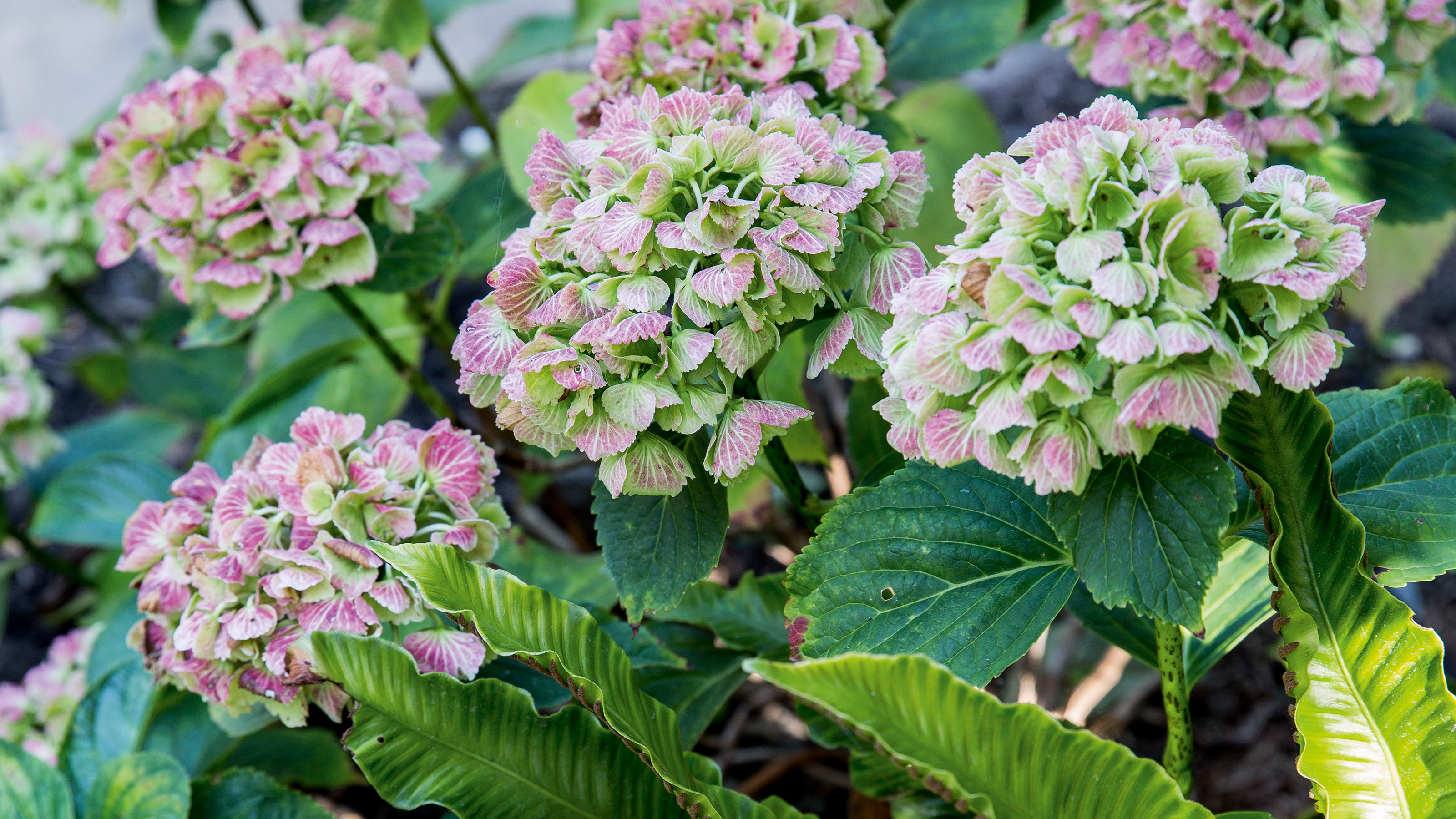
For ease, flower power, and size in semi-shade, these hydrangea varieties are hard to beat. In late summer, they provide mounds of lush foliage and huge flowerheads that can be a handful or more in size. Many of these impressive blooms go through attractive color mutations as the seasons change and make superb cut flowers.
The 75 species are native to Asia and the Americas, with almost 2,000 cultivars. There are three types to choose from: cone-shaped ‘panicle’ flowerheads (including H. paniculata); rounded ’mopheads' (such as H. arborescens); and ‘lacecaps’ (such as H. aspera), which look like doilies.
The ubiquitous mophead forms of H. macrophylla – which are usually pink, but can be blue in certain soil conditions – tend to induce a love or hate reaction. For those who loathe them but are still interested in learning how to grow hydrangeas, there are plenty of gorgeous alternatives, such as the ivory H. arborescens ‘Annabelle’ and the white-flowered climbing hydrangeas, which have a more subtle beauty, with refreshing green and cream tones.
The paniculata hydrangea varieties are another alternative that are loved by garden designers. ‘If I want a flowering shrub that stays around 6ft in sun, I rely on H. paniculata Fire Light,’ says Illinois-based landscape designer Carolyn Gange of Turning Leaf Landscaping. ‘I love how it fades from white to soft maroon.’
Yet another stunning option that is miles away from the gaudier pink mopheads, is the oakleaf hydrangea (H. quercifolia) and its cultivars, such as the splendid Snowflake. ‘I use the oakleaf forms all the time,’ says Carolyn. ‘Ruby Slippers’ is a favorite for its beautiful soft-garnet hue and extraordinary fall color. Snow Queen and Jetstream are statement makers in semi-shade. They bloom earlier than H. paniculata, have better architecture than H. arborescens, bloom more reliably than H. macrophylla, and provide multiple seasons of interest.’
16 stunning hydrangea varieties for huge flower heads
Whichever hydrangea varieties suit your garden, plant them in late spring and look forward to their fabulous flowers brightening the backyard throughout summer and into fall.
If space is tight, there are plenty of compact hydrangea varieties you can choose from too. Mini macrophyllas (such as Jip) are great in ericaceous compost to achieve blue blooms, and dwarf oakleaf forms (such as ‘Munchkin’) offer fantastic fall color.
1. Hydrangea arborescens Strong Annabelle (syn. Incrediball)
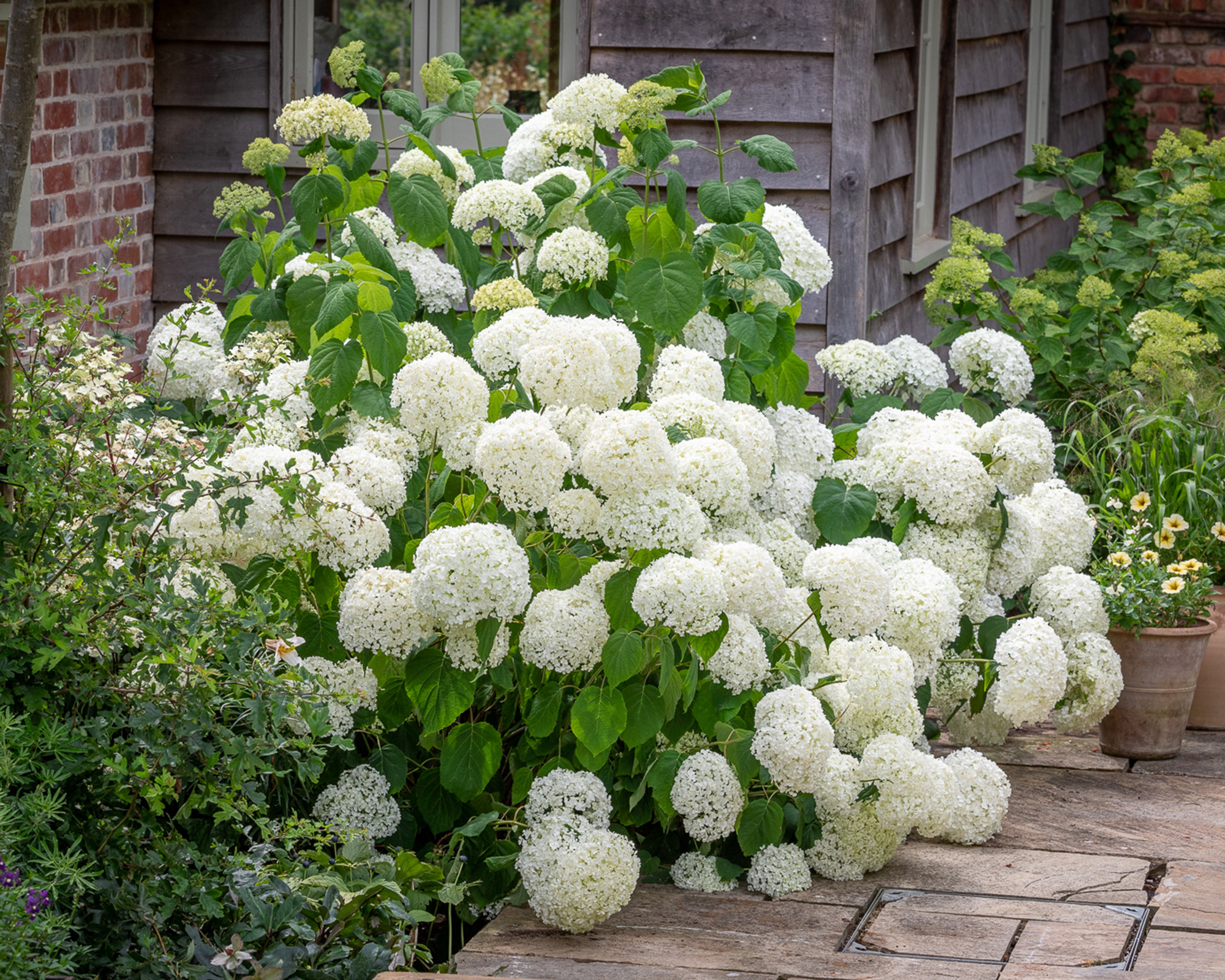
- Hardiness: USDA 3-9 (UK H6)
- Height: 6ft (1.8m)
- Spread: 6ft (1.8m)
If you're landscaping with hydrangeas, this deciduous shrub will provide great structure. It has huge white globe flowerheads (up to 12in/30cm across) that morph to pale green, atop stout stems all the way through summer.
This upgrade of the lovely ‘Annabelle’ hydrangea doesn’t flop after rain and looks great in a vase. Grow it in retentive, well-drained soil in semi-shade.
2. Hydrangea paniculata 'Polar Bear’
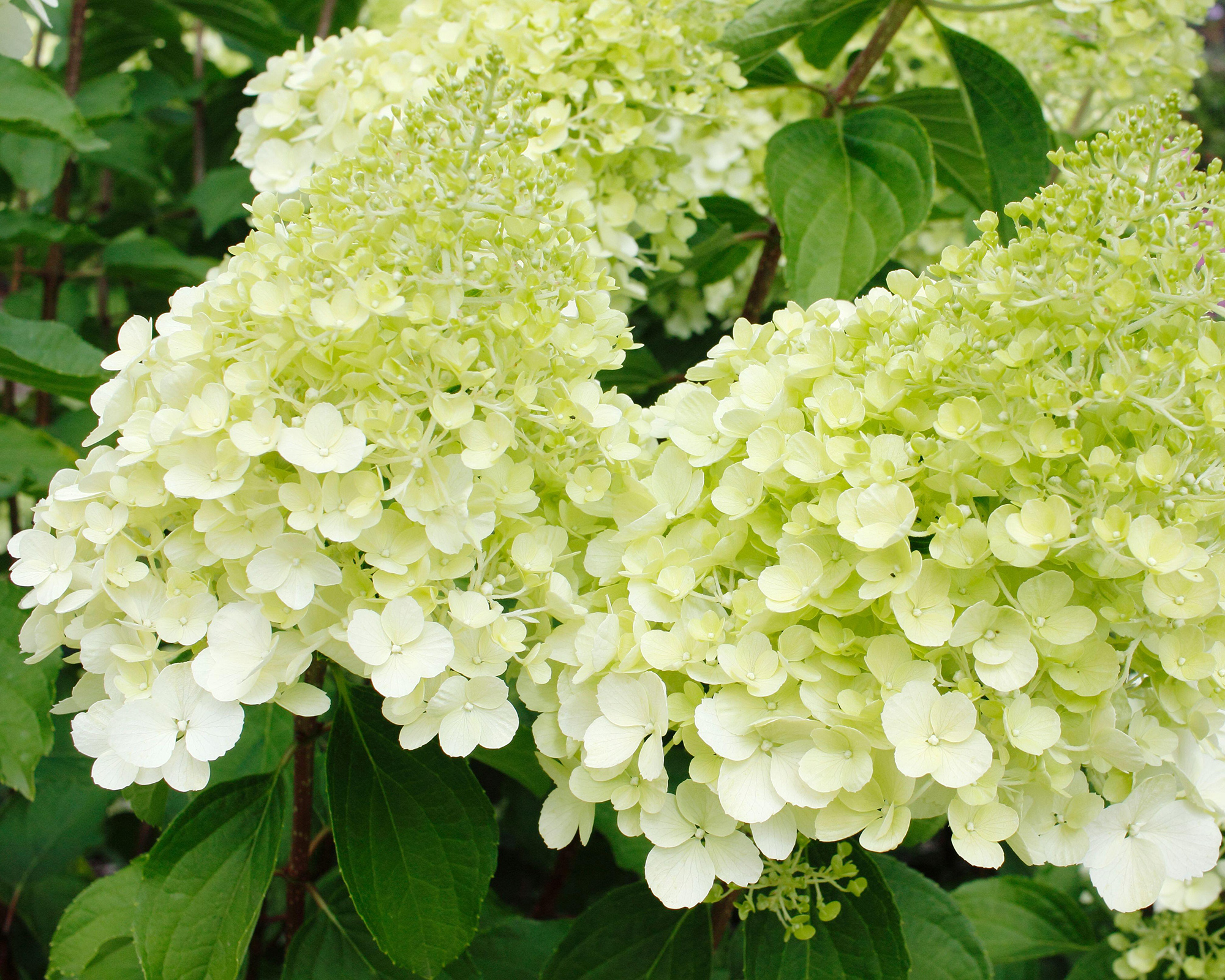
- Hardiness: USDA 3-8 (UK H5)
- Height: 5ft (1.5m)
- Spread: 5ft (1.5m)
This stunning option is recommended by Anne Greenall, who holds a National Collection of hydrangeas through Plant Heritage UK: ‘It’s a beautiful, compact paniculata with greeny cream-white conical-shaped flowers that are upright in growth,’ she says.
Grow this shrub in well-drained, humus-rich soil in sheltered sun or semi-shade for gorgeous flowers in late summer and early fall.
It's worth remembering that pruning hydrangeas back too hard the previous year will mean that they won't flower as successfully in summer.
3. Hydrangea paniculata ‘Limelight'
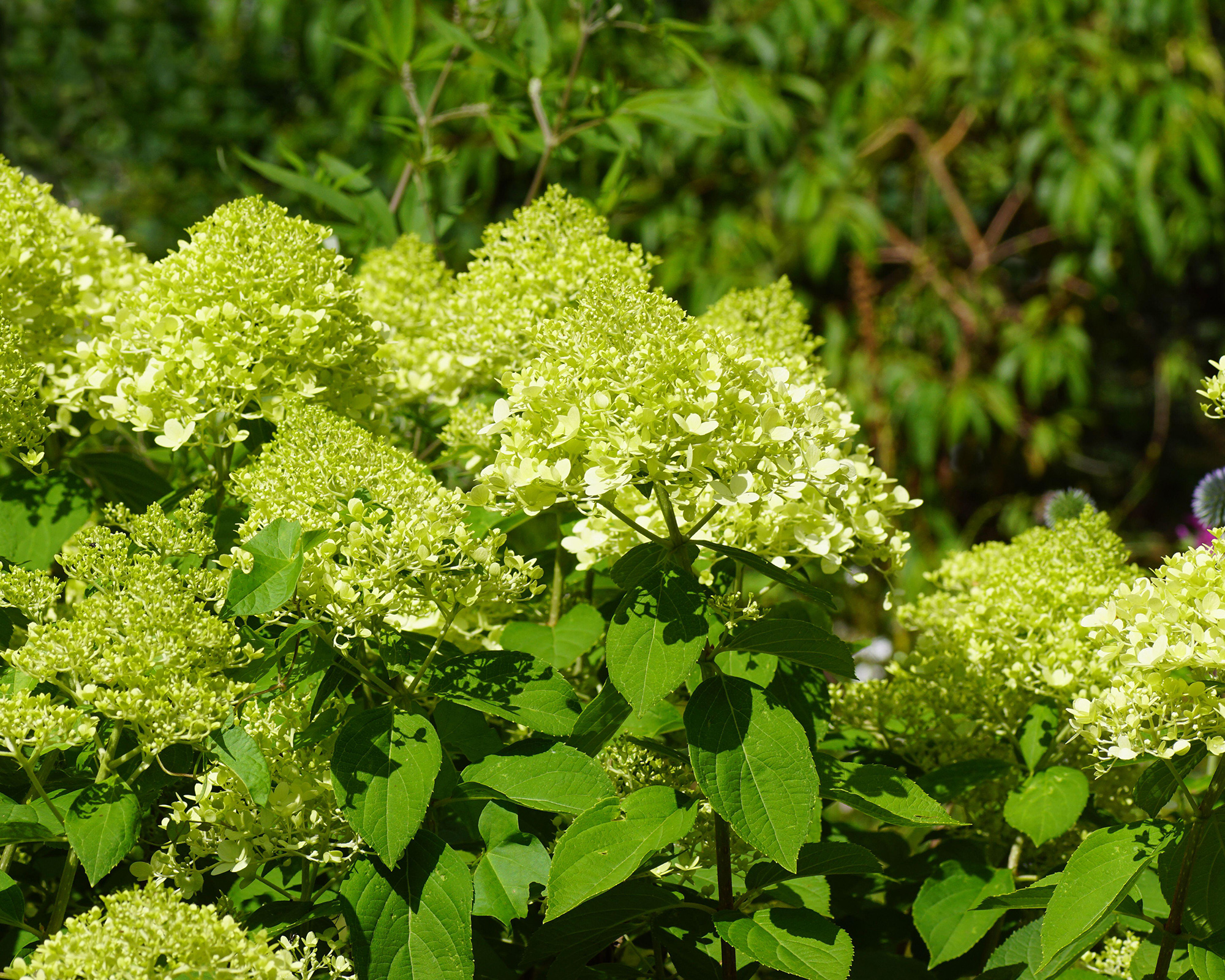
- Hardiness: USDA 3-8 (UK H5)
- Height: 10ft (3m)
- Spread: 10ft (3m)
This shrub has fabulous lime flower cones from summer that morph to cream and then pink.
‘For low-maintenance shrubs, H. paniculata cultivars such as ‘Limelight’ should be top of the list,’ says Brad MacDonald at the Surfing Hydrangea Nursery in Massachusetts. ‘They’re easy in a wide range of conditions and flower consistently year after year.’
4. ‘Preziosa’ (syn. Hydrangea serrata ‘Preziosa’)
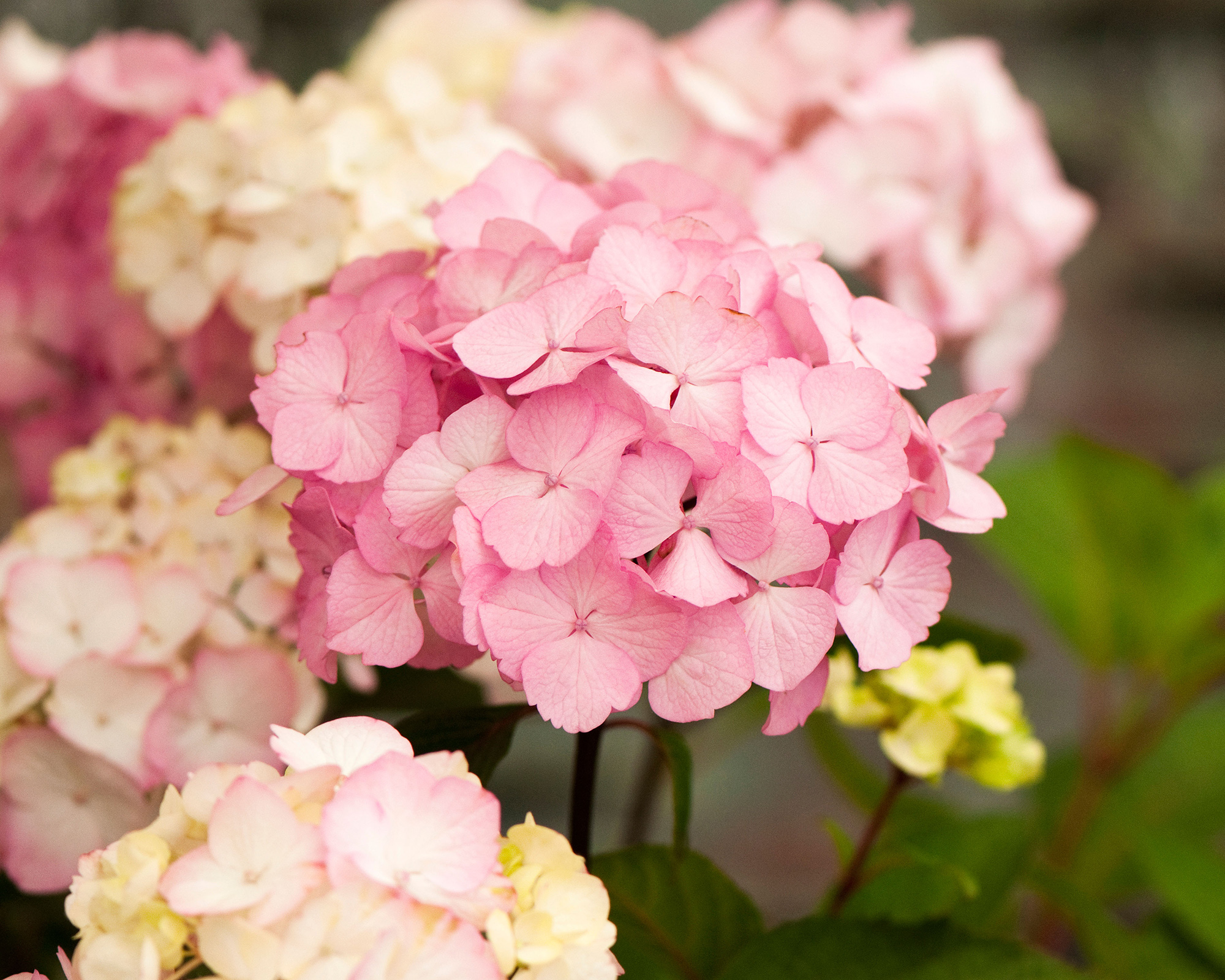
- Hardiness: USDA 6-9 (UK H4)
- Height: 4ft (1.2m)
- Spread: 4ft (1.2m)
‘For me, this hydrangea is the best all-rounder,’ says Anne Greenall. ‘It starts a light pink, changing through the season to a dark pink, with dark leaves, and it dries well.’
It forms a small to medium-sized deciduous shrub in well-drained humus-rich soil in sun or semi-shade.
If you want to know how to dry flowers, cut the heads off, waiting until the fall to harvest them. Or save the flowerheads in fall to collect seeds for propagating hydrangeas.
5. Hydrangea quercifolia 'Ruby Slippers’
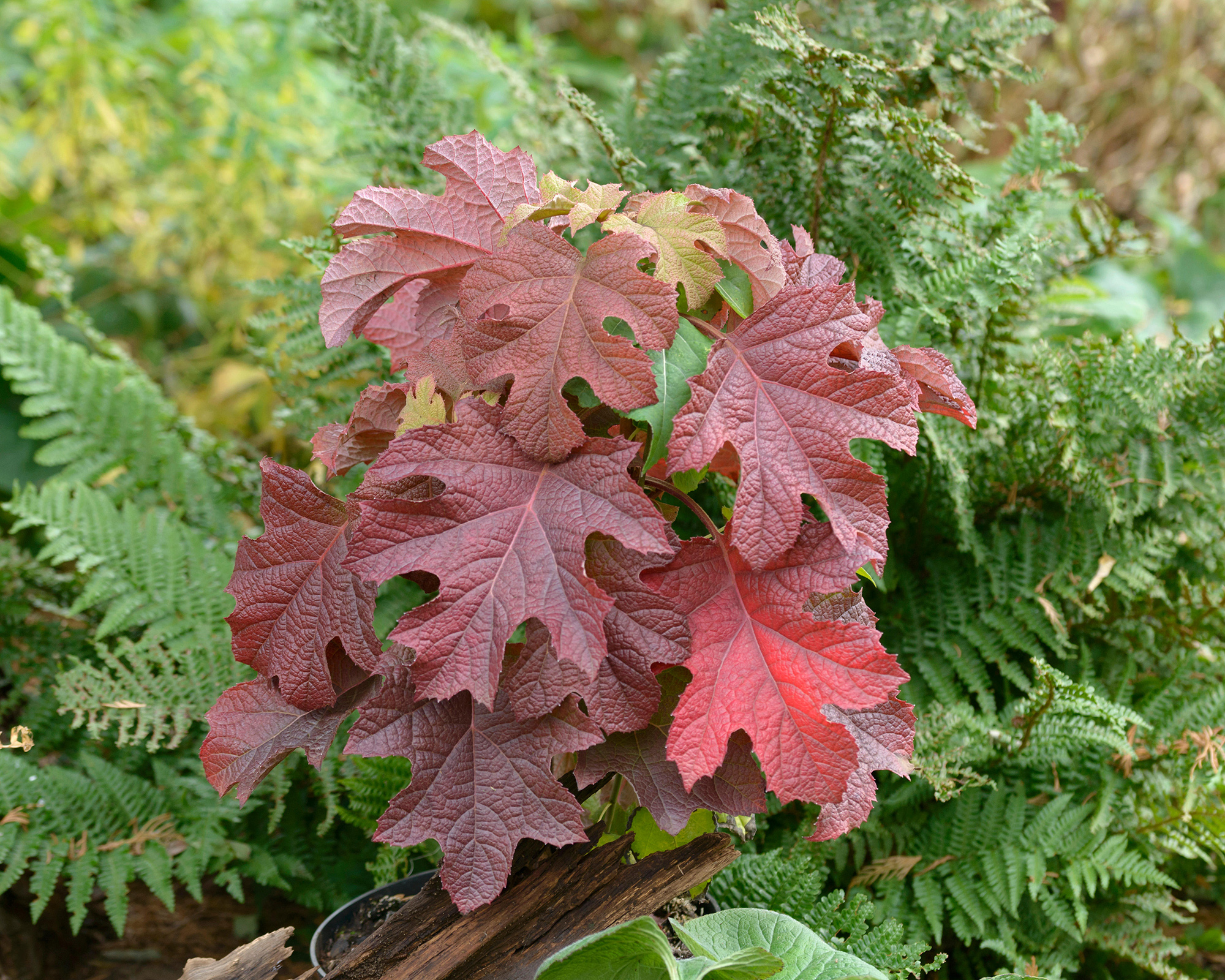
- Hardiness: USDA 5-9 (UK H5)
- Height: 4ft (1.2m)
- Spread: 5ft (1.5m)
‘I am in love with oakleaf hydrangeas, especially this one,’ says Pennsylvania-based landscape designer Nathan Tuno, who works at Roots Landscape Inc. ‘The oak-shaped leaves are large and the flowers are an exaggerated bottlebrush shape.’
The blooms morph from white to pink to rich red, and the foliage blushes dark-red in the fall, especially in sun.
6. Hydrangea paniculata Vanille Fraise
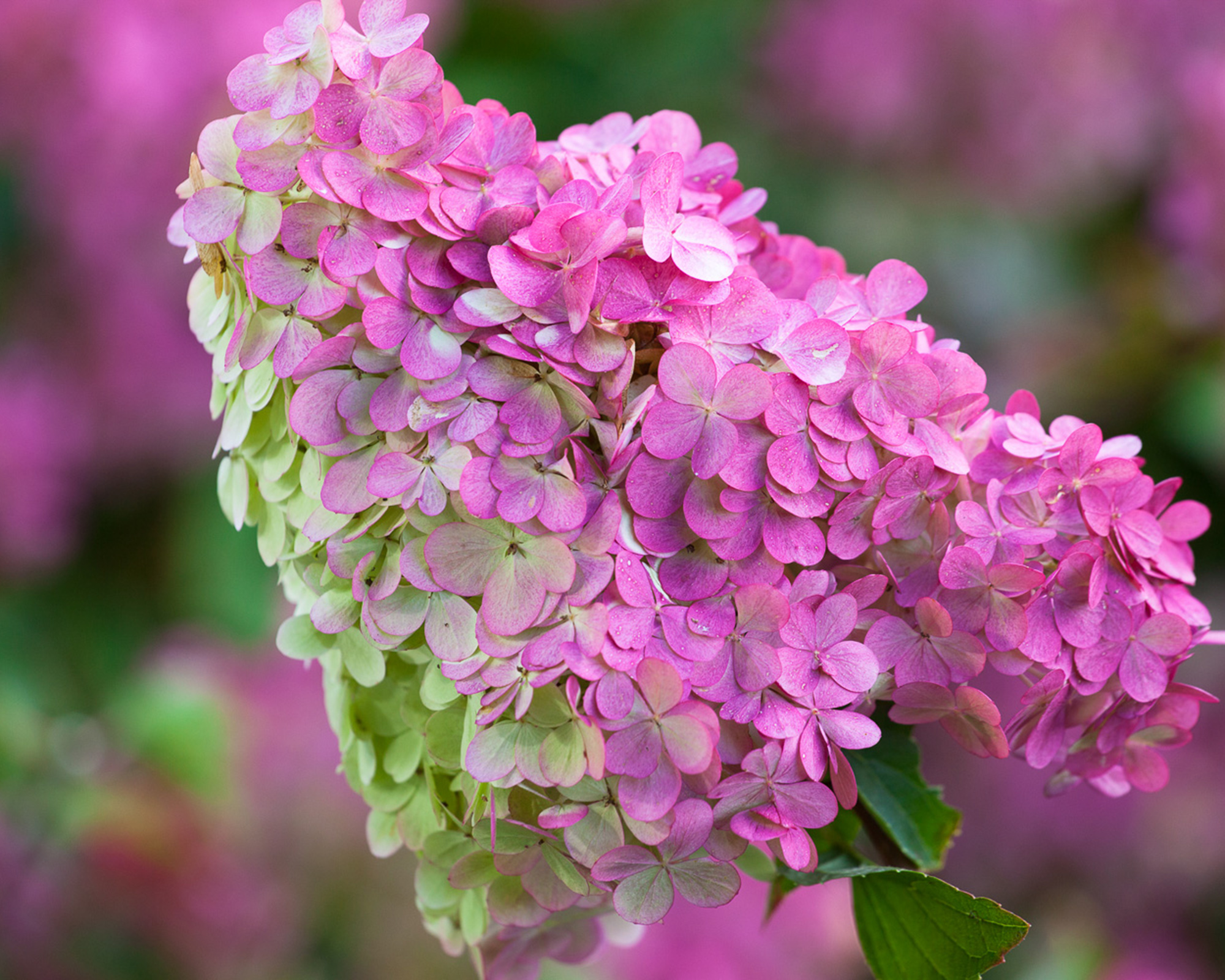
- Hardiness: USDA 3-8 (UK H5)
- Height: 6ft (1.8m)
- Spread: 4ft (1.2m)
This deciduous shrub throws up claret stems carrying large panicles of ivory and pink flowers, like cones of strawberry and vanilla ice cream, from midsummer; then in the fall, they take on rich raspberry-red tones.
Having an arching habit, they make beautiful cottage garden plants or work well in an informal garden. Grow in well-drained humus-rich soil in sun or semi-shade.
7. Hydrangea macrophylla 'Blaumeise' (Teller Series)
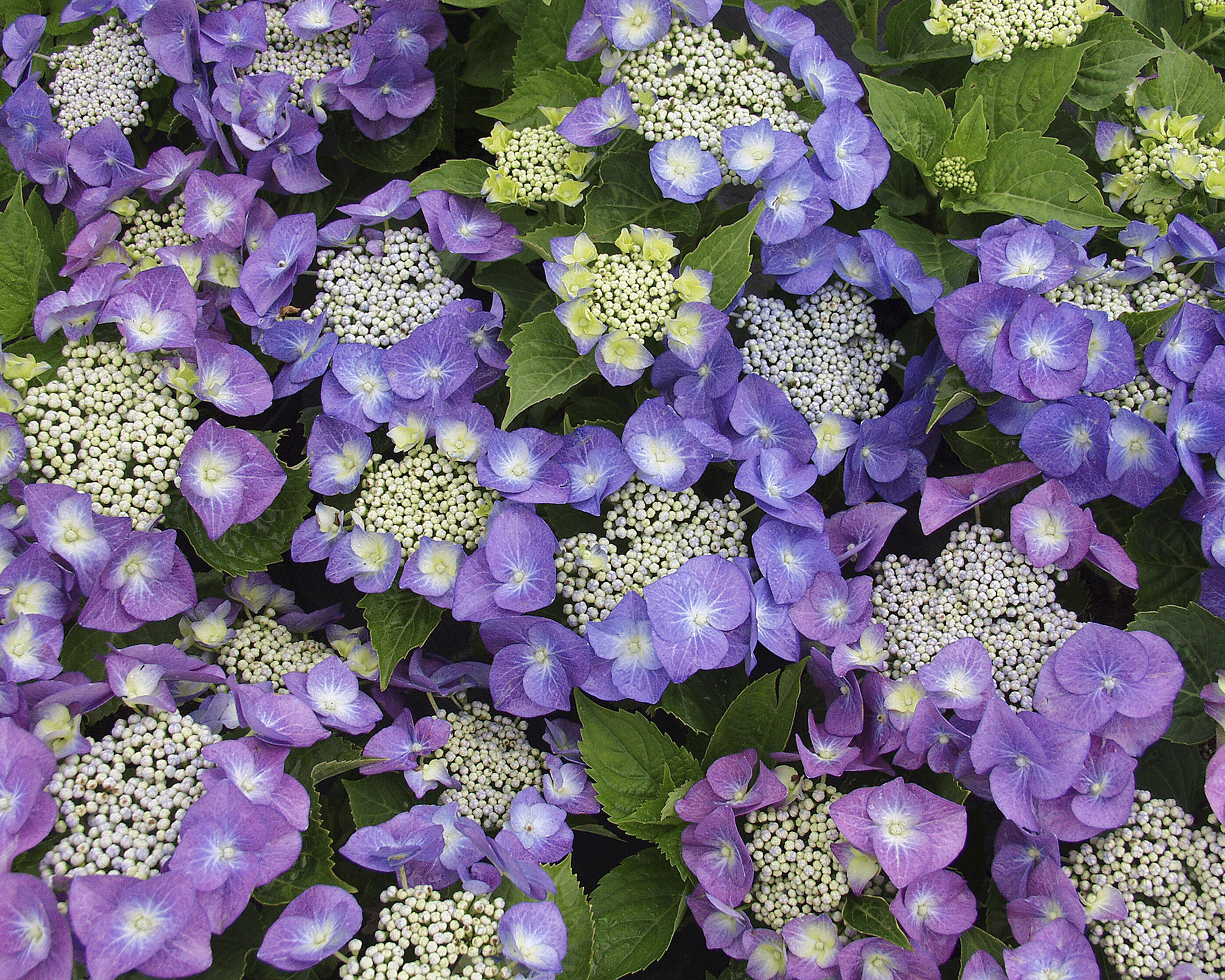
- Hardiness: USDA 5-9 (UK H5)
- Height: 5ft (1.5m)
- Spread: 5ft (1.5m)
‘In my garden, which has acid soil, this has vivid to dark blue striking flowers,’ says Anne. ‘It’s a fairly upright, hardy plant, medium or tall, if left to do its own thing.’
The color of hydrangeas can change depending on what type of soil they are growing in. ‘Blaumeise’ (which means blue tit) is a lacecap variety that may be mauve-pink on neutral or alkaline soils. Grow in well-drained, retentive, fertile soil types in semi-shade.
8. Hydrangea macrophylla Endless Summer
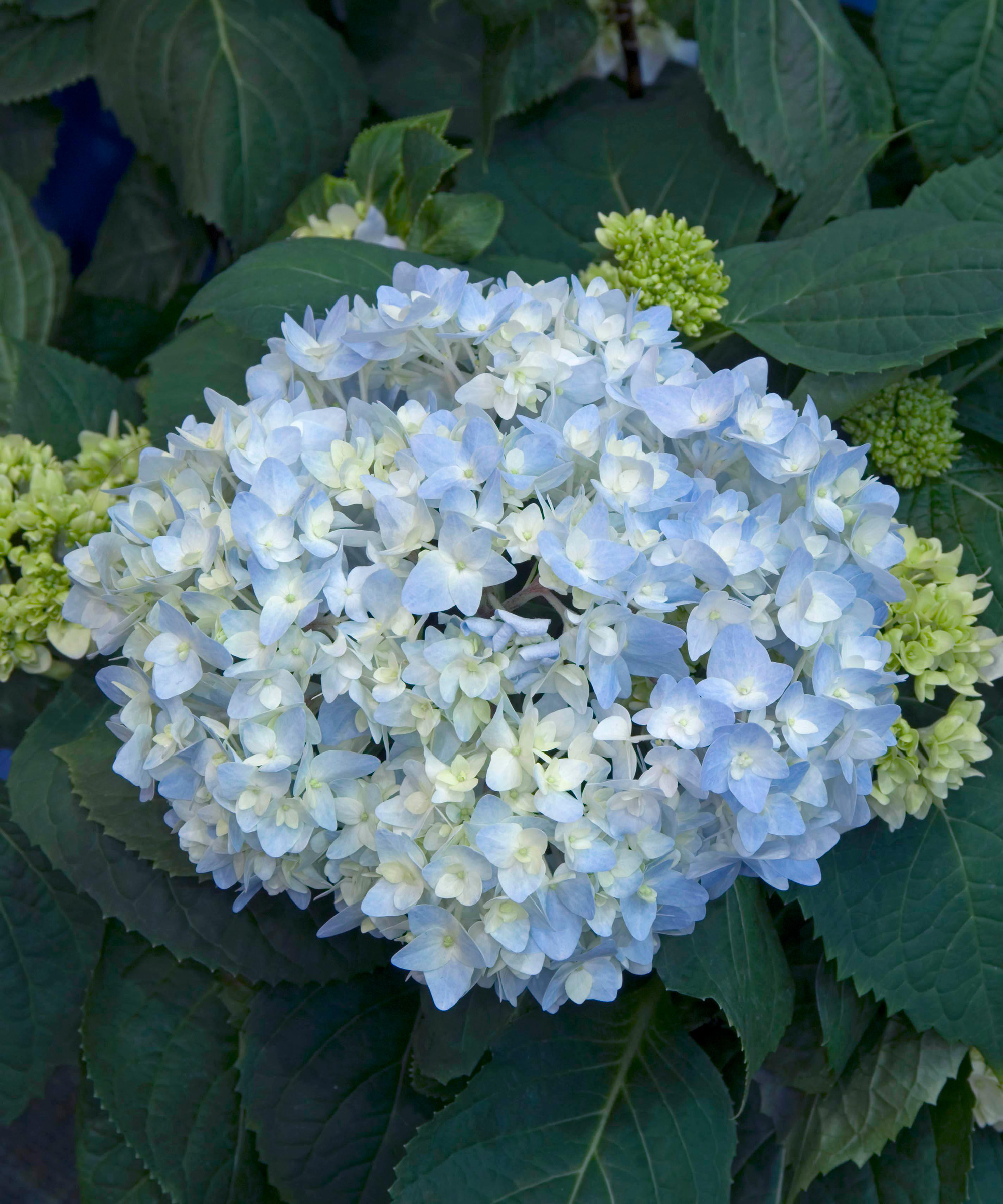
- Hardiness: USDA 4-9 (UK H7)
- Height: 4ft (1.2m)
- Spread: 5ft (1.5m)
A floriferous mophead hydrangea for rounded flowerheads, that develop attractive sky-blue tones on acid soil types and soft-pink colors on alkaline soils. Brad MacDonald recommends this is a great choice for growing pastel-blue or light-pink flowers to dry for the house.
Grow this deciduous shrub in well-drained, fertile, retentive soil in a sheltered site in semi-shade e.g. as a woodland plant beneath the shade of a tree.
9. Hydrangea serrata Tuff Stuff (syn. Blueberry Cheesecake and Cotton Candy)
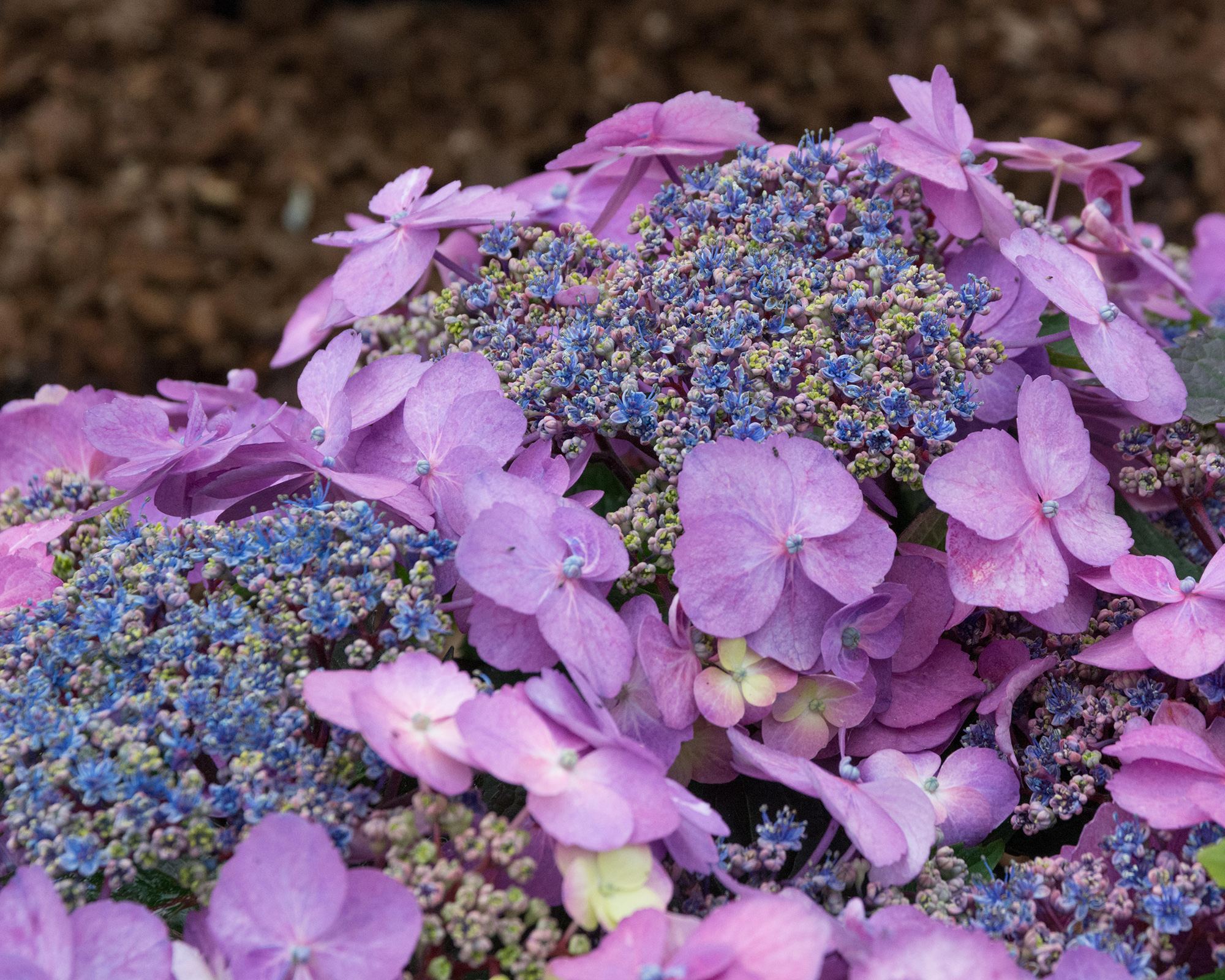
- Hardiness: USDA 5-9 (UK H4)
- Height: 3ft (90cm)
- Spread: 3ft (90cm)
A floriferous, hardy, compact lacecap that is blue on acid soil and pink on alkaline soil. ‘Blueberry Cheesecake (blue) and Cotton Candy (pink) are the same plant grown in different soil,’ say Fiona and Roger Butler, who own the Signature Hydrangeas nursery in Kent. ‘The leaves have good fall color.’
10. Hydrangea anomala subsp. petiolaris
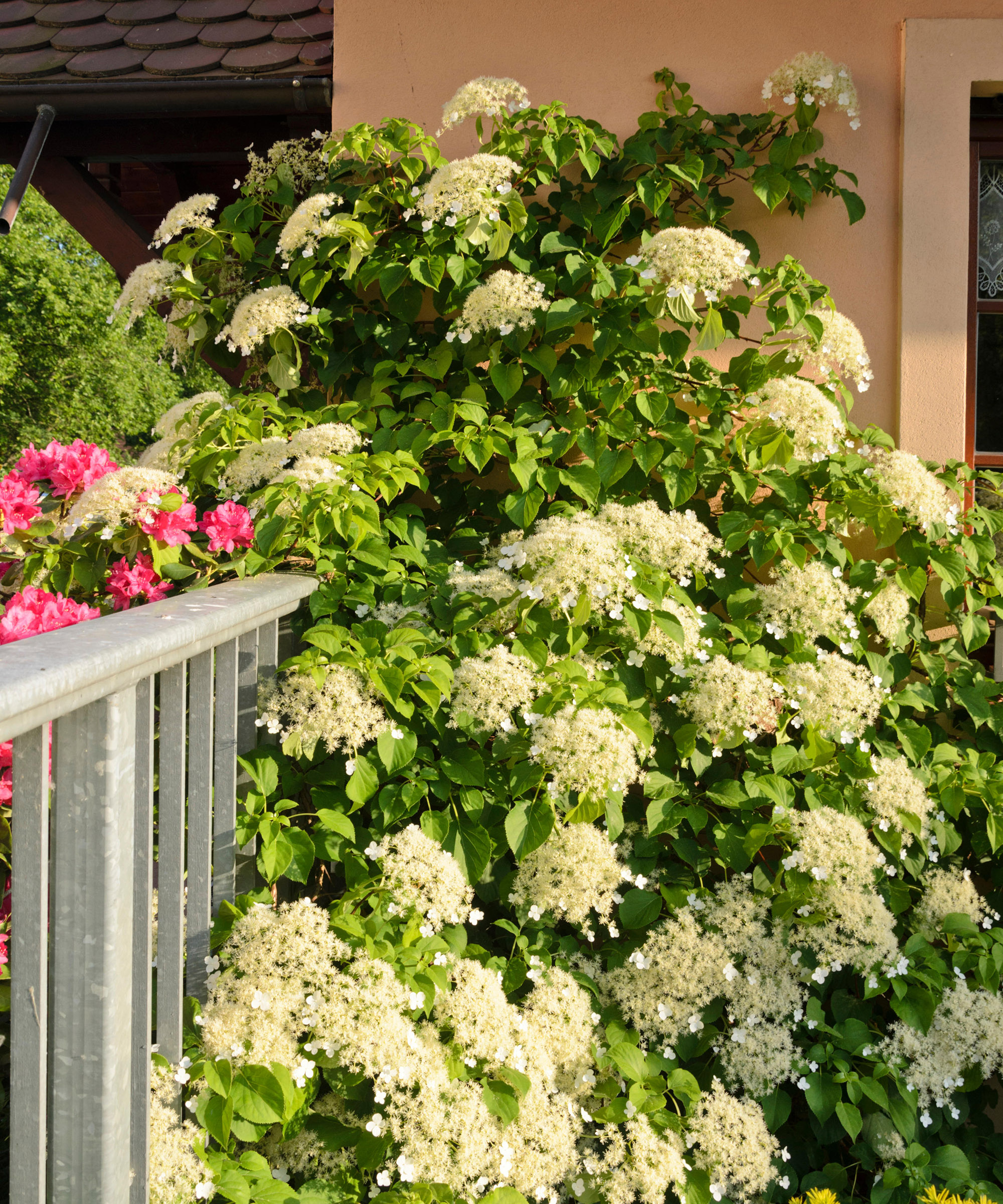
- Hardiness: USDA 4-8 (UK H5)
- Height: 40ft (12m)
- Spread: 13ft (4m)
A wonderful deciduous climbing plant for a shady wall. In summer, the oval green leaves are paired with huge, lacy white flowerheads.
After taking time to establish, it is vigorous in fertile, retentive, well-drained soil in sheltered semi-shade. It is self-clinging via aerial roots, but its mature weight can force it off the wall, so make sure you provide it with adequate climbing plant support.
11. Hydrangea seemannii
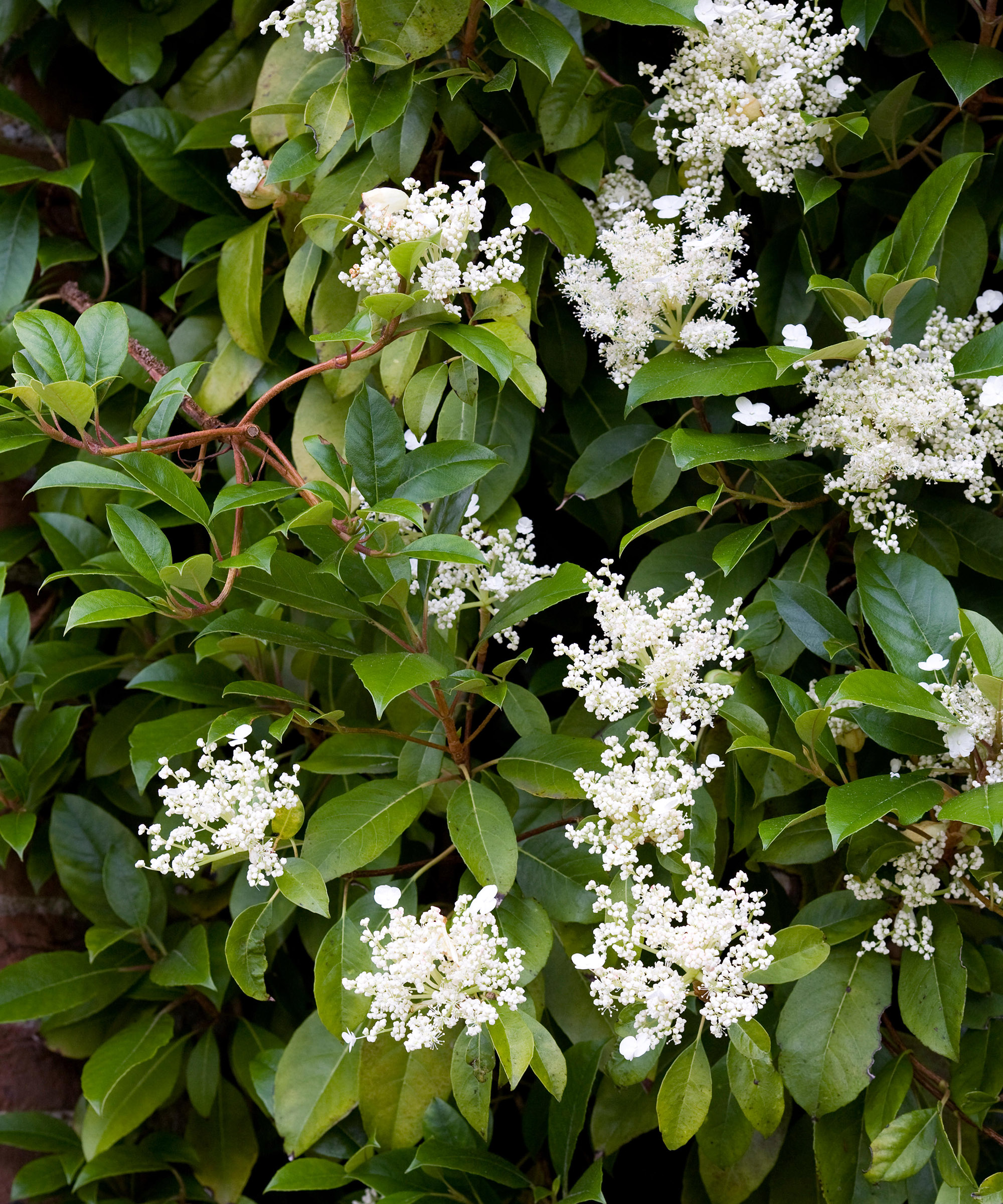
- Hardiness: USDA 8-10 (UK H4)
- Height: 30ft (10m)
- Spread: 13ft (4m)
A self-clinging evergreen climber from Mexico, for a sheltered shady wall in mild areas, this has glossy, leathery leaves and ivory summer flowers that are fragrant in the evening.
Like most climbing hydrangeas, it can be slow to establish, but growth can be speeded up and it can be used as a plant for covering walls by removing the flowers for the first few years. Plant in fertile, well-drained, retentive soil.
12. Pileostegia viburnoides
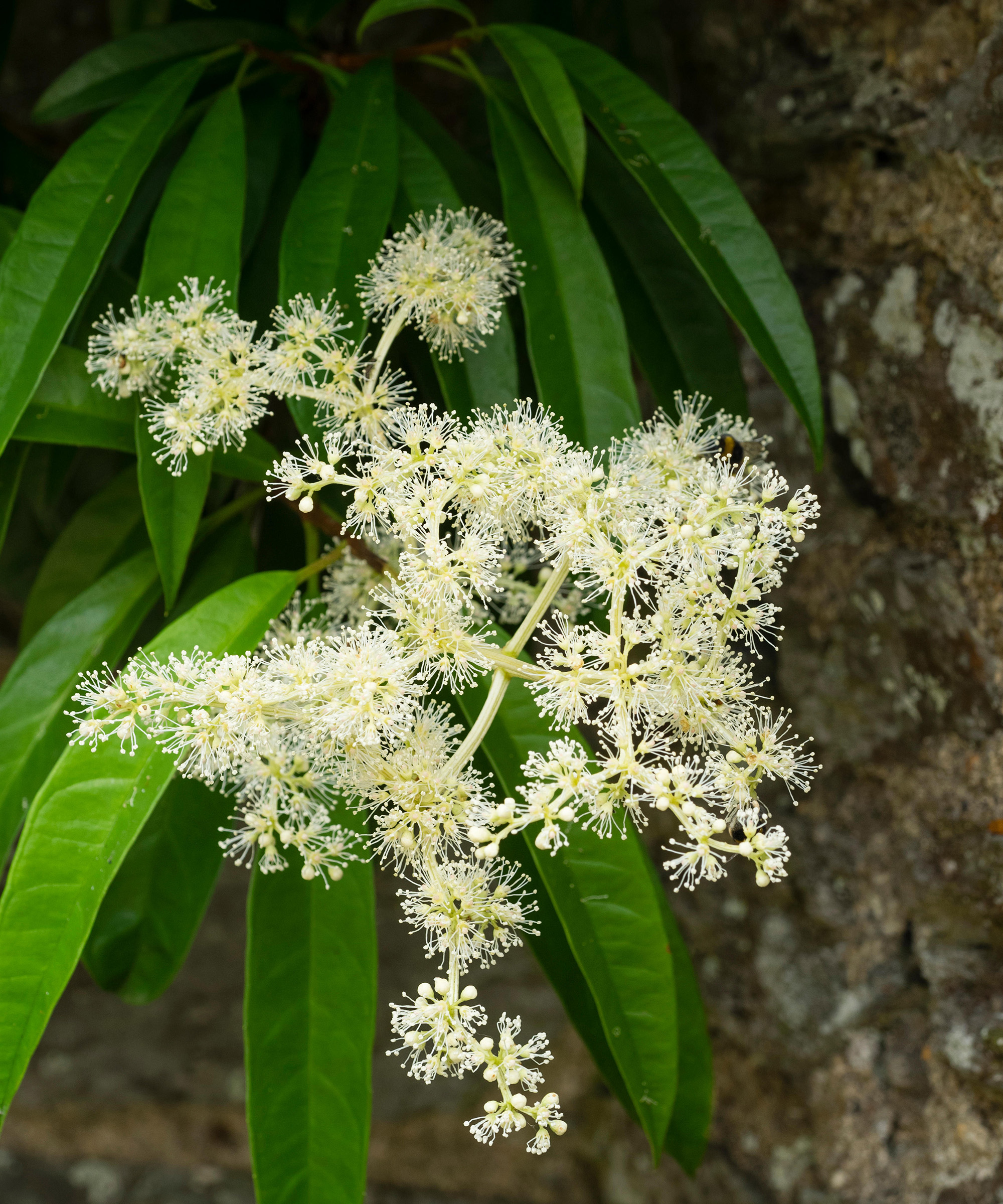
- Hardiness: USDA 8-10 (UK H5)
- Height: 20ft (6m)
- Spread: 13ft (4m)
A superb climbing hydrangea and a great plant for pollinators, this produces nectar-rich fleecy creamy white flowers in late summer and fall.
The long, glossy evergreen leaves also make it a great foliage plant for a shady wall. It is slow to establish, but worth the wait.
Plant in fertile, retentive, well-drained soil in sheltered semi-shade or shade and give nitrogen-rich food.
13. Hydrangea quercifolia 'Pee Wee’
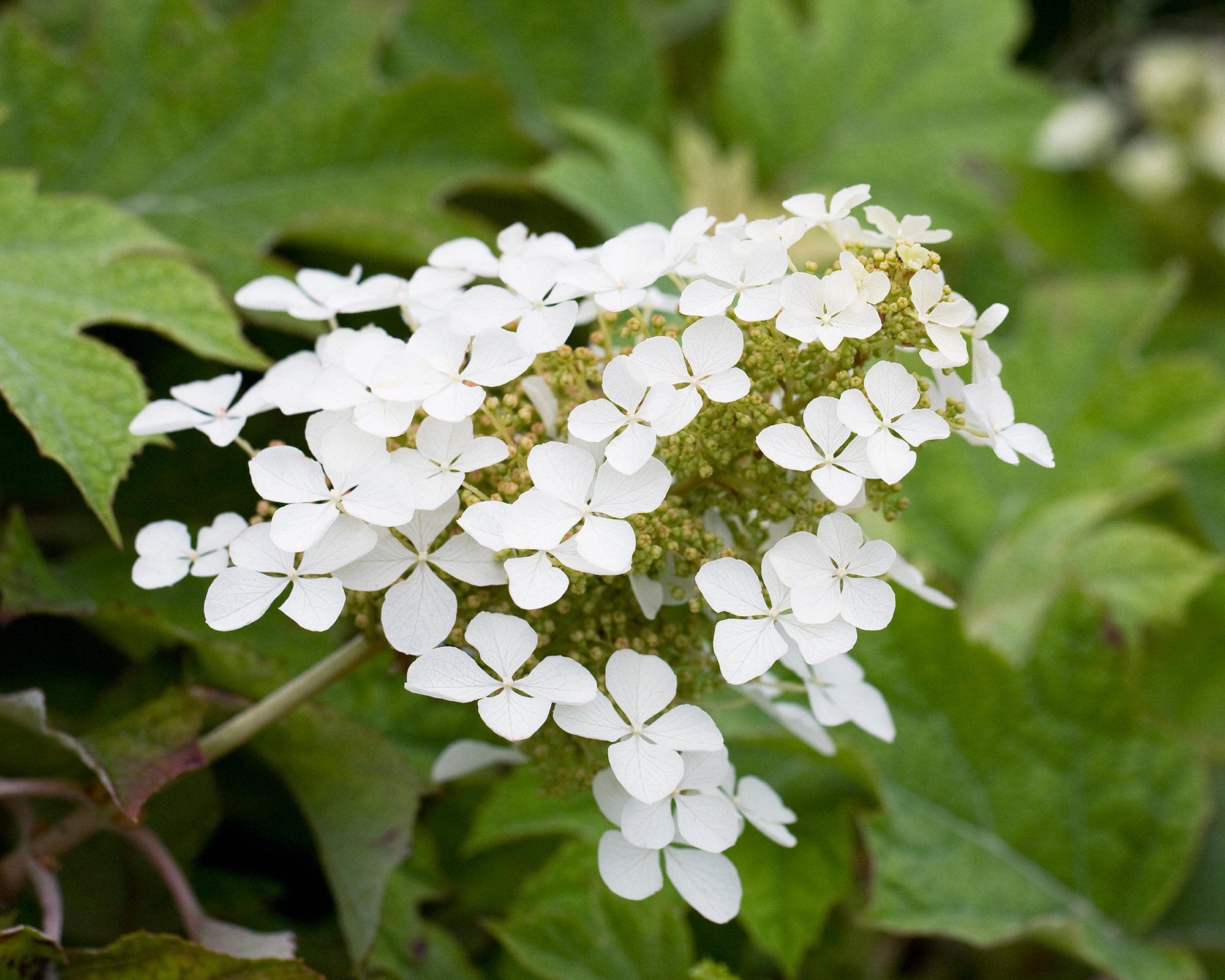
- Hardiness: USDA 5-9 (UK H5)
- Height: 3ft (90cm)
- Spread: 3ft (90cm)
A lovely mound-forming oakleaf hydrangea that is small enough to include in your container gardening ideas. The cone-shaped ivory-white flowers sometimes take on pale-pink tones in the fall, when the oak-shaped leaves blush shades of purple and red.
Plant in well-drained containers of multi-purpose compost and place in sunshine for the best fall leaf colors.
14. Hydrangea macrophylla Magical Amethyst (Magical Series)
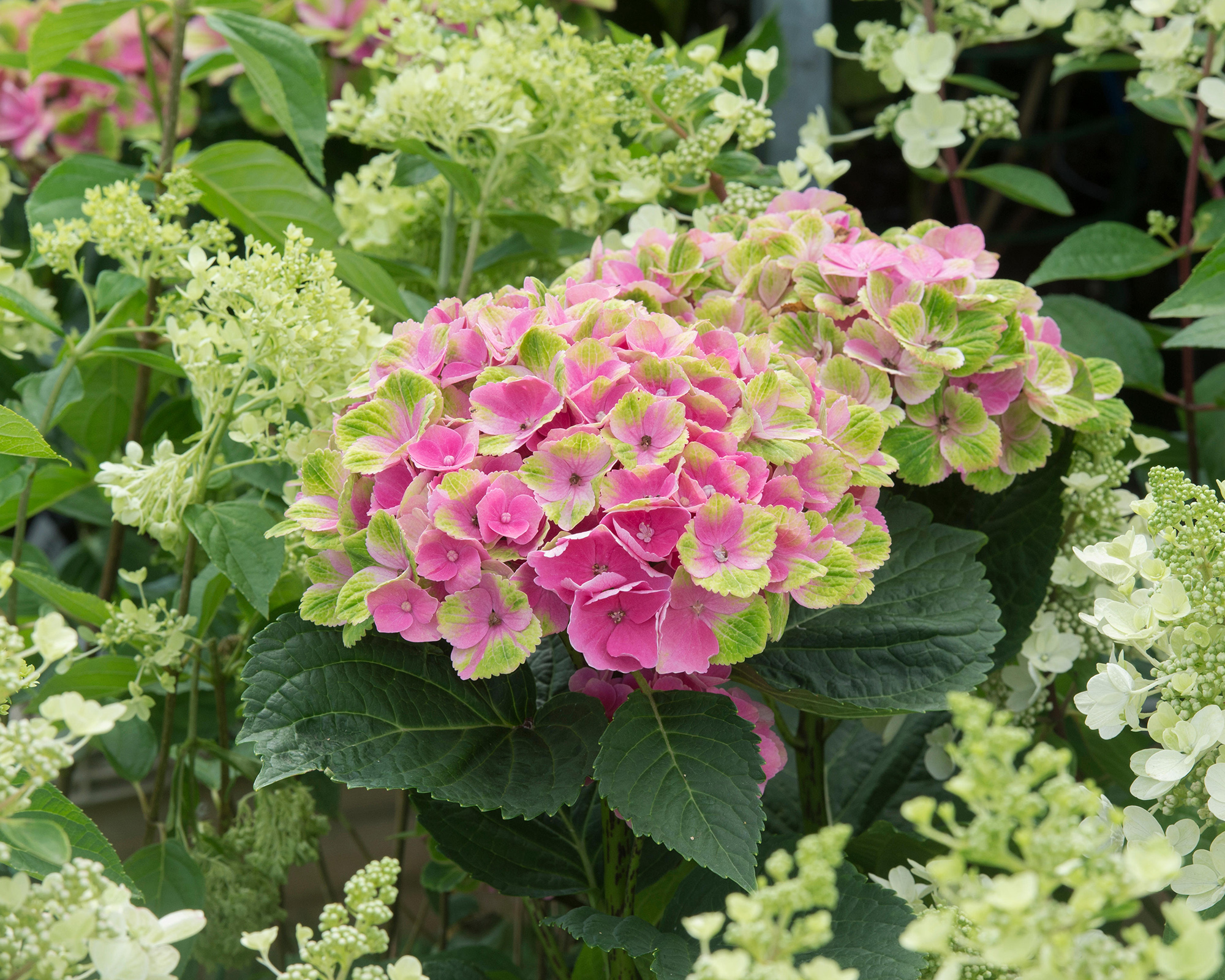
- Hardiness: USDA 5-9 (UK H5)
- Height: 4ft (1.2m)
- Spread: 3ft (90cm)
A compact mound-shaped deciduous shrub that produces two-tone flowerheads over a long period.
On acid soils or in garden planters filled with ericaceous compost, these are lime and blue, and on alkaline soils or in pots of multi-purpose compost, they are lime and pink. Eventually, the flowers all morph to green.
15. Hydrangea paniculata ‘Jane' (syn. ‘Little Lime’)
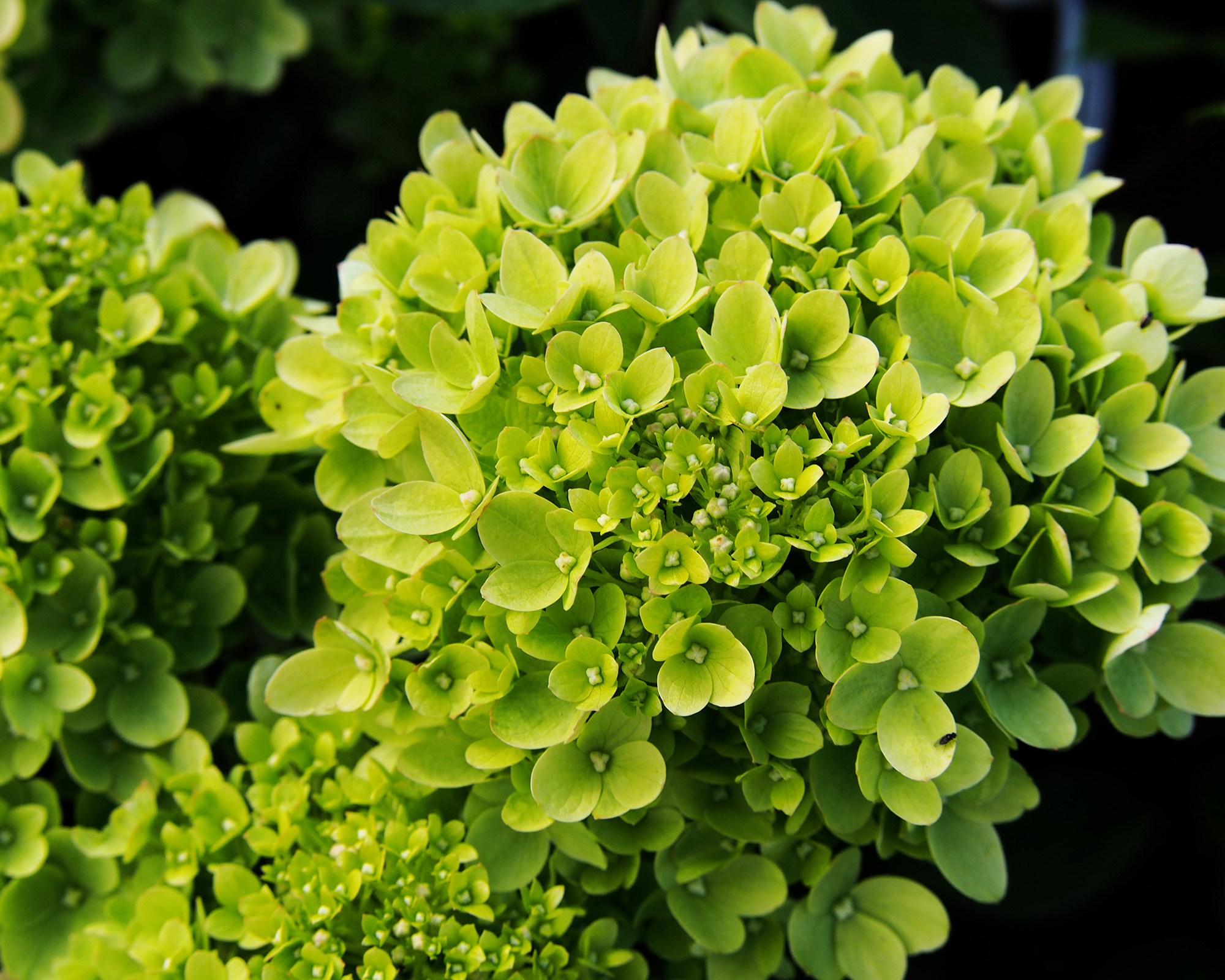
- Hardiness: USDA 3-8 (UK H5)
- Height: 4ft (1.2m)
- Spread: 4ft (1.2m)
Gorgeous panicles of lime-green flowers fade to jade then ivory and then take on pink tones in the fall. Even ardent hydrangea haters will love it.
Ideal for patio gardening ideas, you can plant this compact deciduous shrub in a well-drained pot of multi-purpose or ericaceous compost and place in sun or semi-shade. When caring for hydrangeas in pots, you must remember to water well, especially in hot, dry weather.
16. Hydrangea macrophylla ‘Masja'
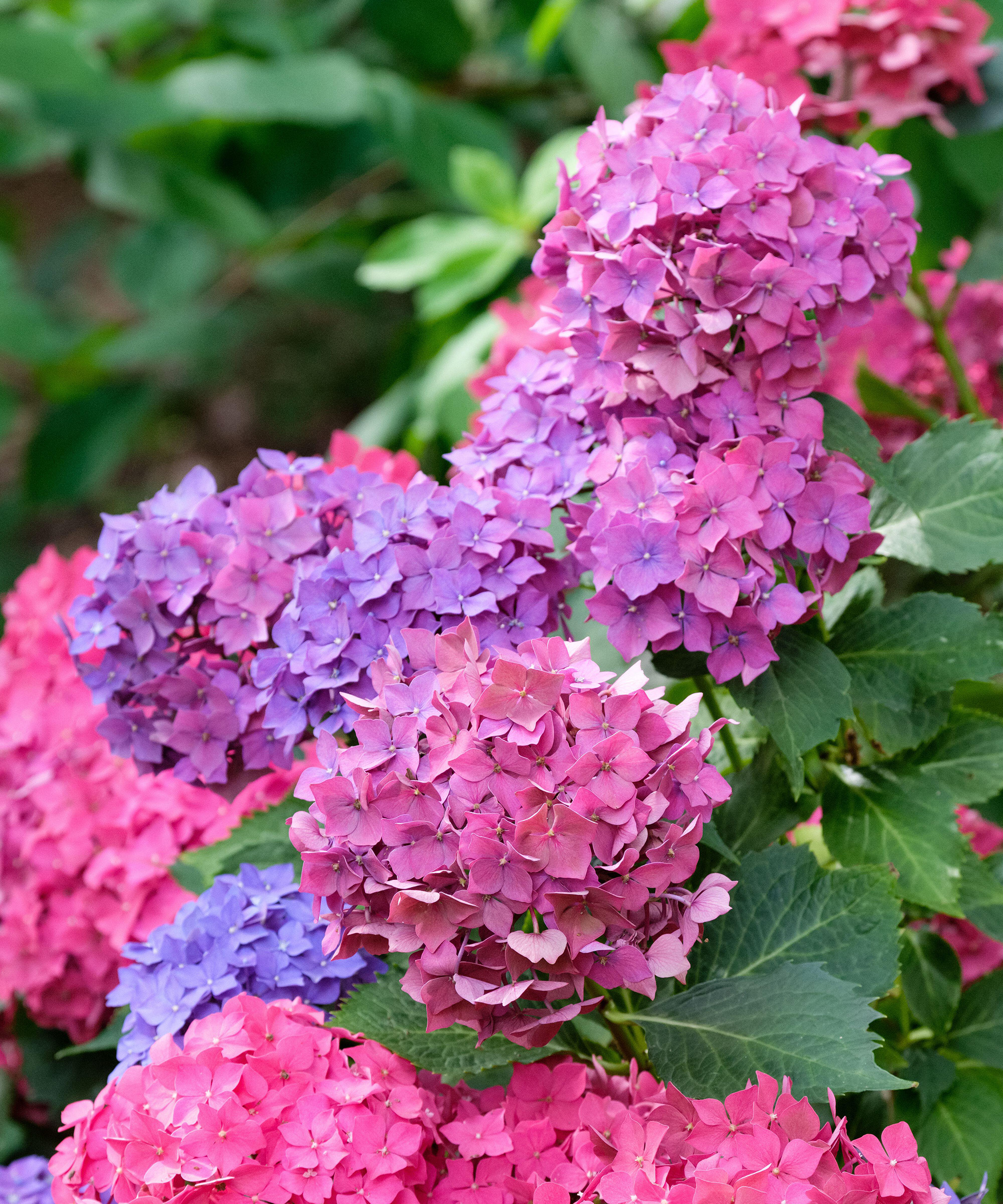
- Hardiness: USDA 6-9 (UK H5)
- Height: 3ft (90cm)
- Spread: 3ft (90cm)
A compact mophead hydrangea that produces rich-red flowers from mid to late summer in alkaline soil and takes on purple tones in acid soil.
Plant in a well-drained pot of ericaceous compost for purple-pink flowers or multi-purpose peat-free compost for red flowers, and place in sheltered semi-shade. Water regularly, especially in hot, dry weather.
What is the most common type of hydrangea?
Hydrangea macrophylla is the most widely grown. Commonly known as hortensia or French hydrangea (even though it is native to Japan), it has large mophead or lacecap flowerheads that are usually mid-pink in alkaline soils and mauve or blue in acid soils.
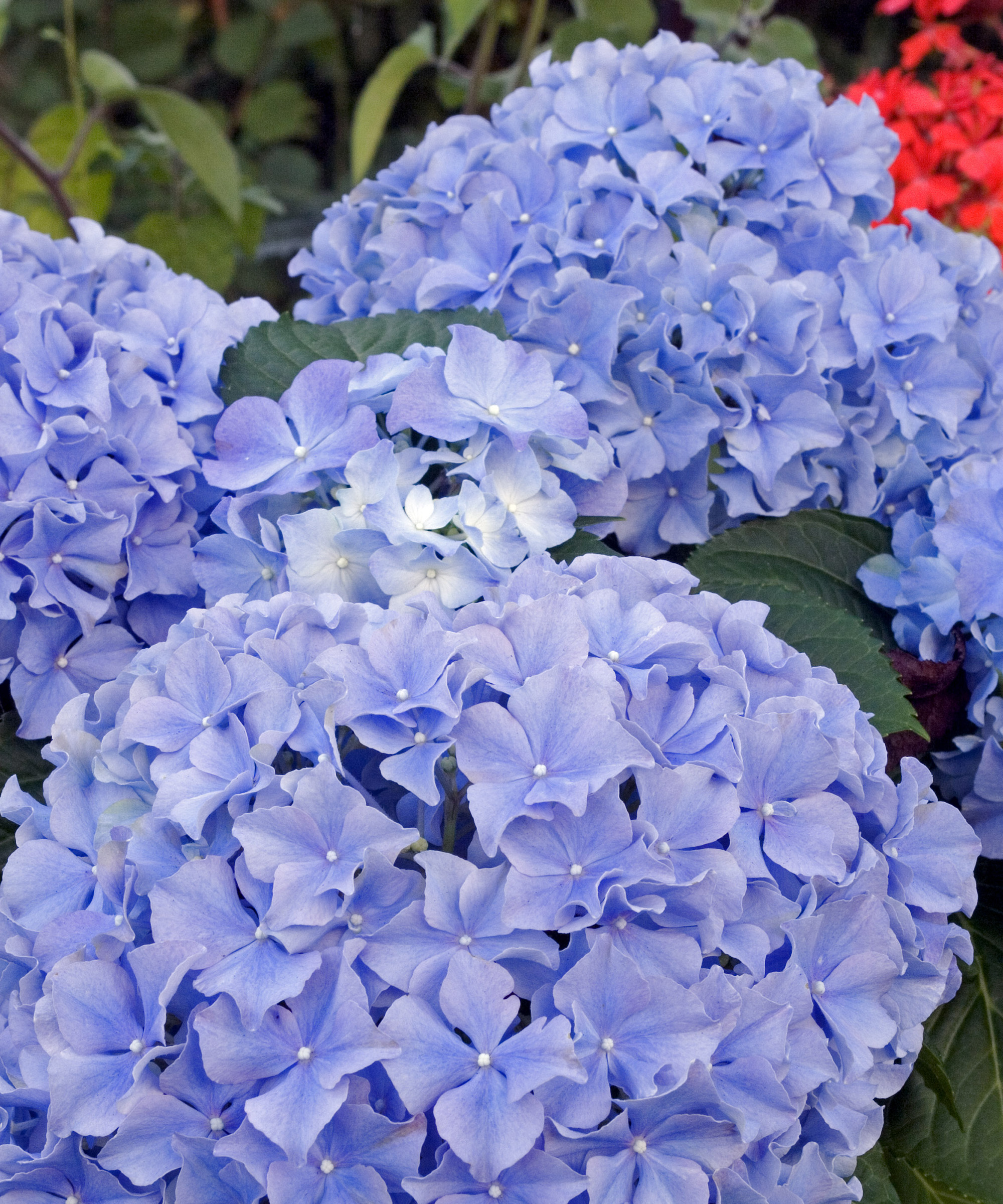
How many different varieties of hydrangea are there?
Almost 2,000! Choose the best for your garden by considering the color and size you want. Some hydrangeas are large shrubs, while others are compact enough to grow in containers. There are also lovely climbing hydrangeas for shady walls.
How do I know what type of hydrangea I have?
Look at the shape of the flowers. If the flowers look like lacecaps, it could be a form of H. macrophylla, H. serrata, H. arborescens, or H. aspera. If they are rounded mopheads, you probably have H. macrophylla or H. arborescens. And if they are cone-shaped, it is likely to be H. paniculata or H. quercifolia. H. quercifolia has unique foliage: reminiscent of oak leaves and producing great autumn color.
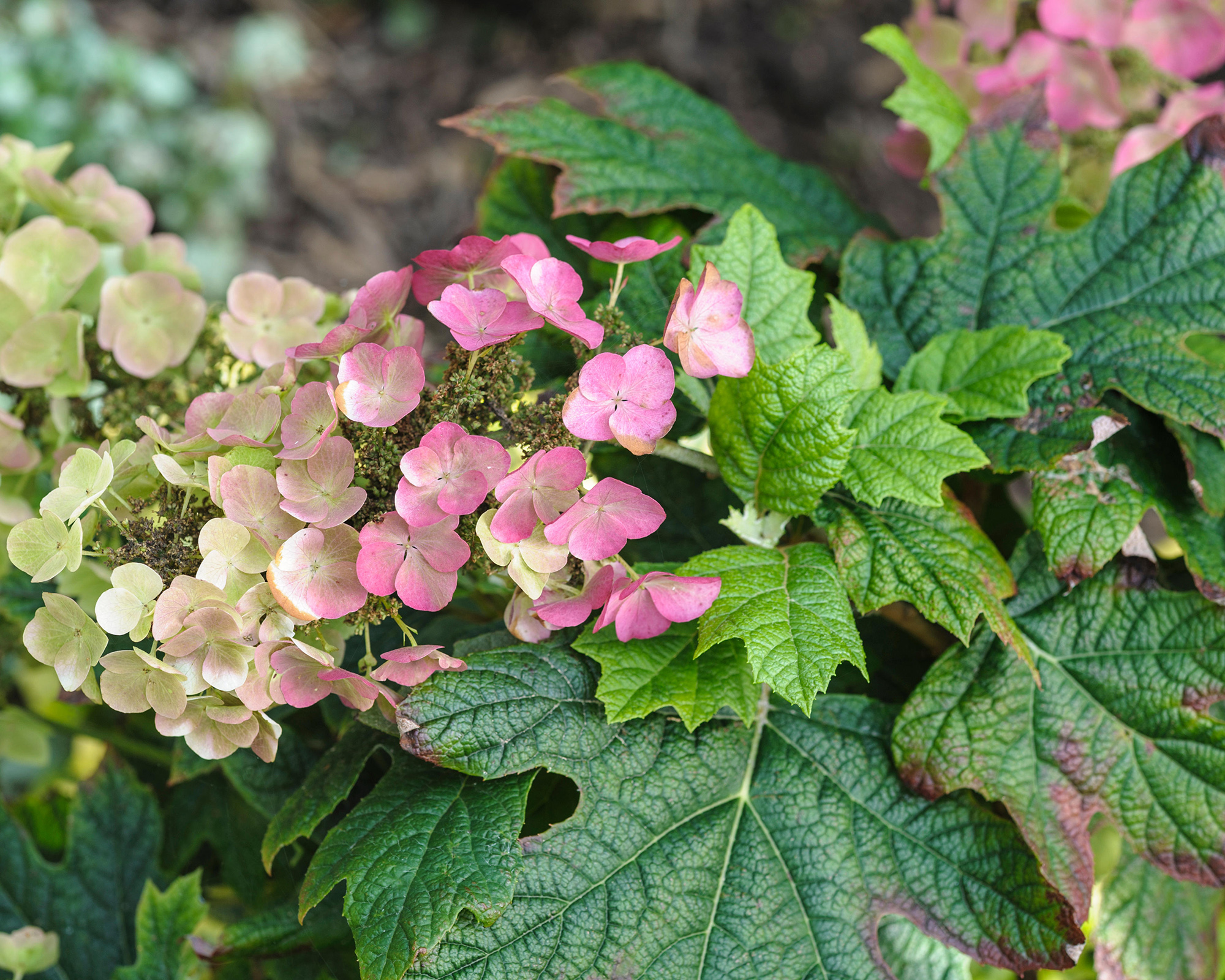
What is the best hydrangea for wildlife?
The lovely climbing hydrangeas – such as H. anomala subsp. petiolaris and Pileostegia viburnoides – are best for pollinators, such as bees. But some of the shrubby hydrangeas are also good for wildlife gardens.
’We have always found that hydrangeas native to North America provide the most pollen for bees,’ says Brad MacDonald. ‘The native species H. arborescens and its lace-cap cultivars, such as ’Haas' Halo’, tend to provide more pollen than mophead H. arborescens cultivars, such as ‘Annabelle’.’
Where to buy hydrangeas
Ready to add some of these stunning plants to your garden borders, pots and containers? Use our quicklinks to head straight to leading retailers:
Where to buy hydrangeas in the US:
- Shop hydrangea plants at Amazon
- Shop hydrangea plants at Burpee
- Shop hydrangea plants at Lowe's
- Shop hydrangea plants at Monrovia
- Shop hydrangea plants at Nature Hills
- Shop hydrangea plants at Spring Hill Nursery
Where to buy hydrangeas in the UK:

The garden was always a big part of Holly's life growing up, as was the surrounding New Forest where she lived. Her appreciation for the great outdoors has only grown since then. She's been an allotment keeper, a professional gardener, and a botanical illustrator – plants are her passion.
